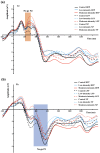The Impact of Acute Aerobic Exercise on General and Food-Related Inhibitory Function Among Young Adults with Obesity: An Event-Related Potential (ERP) Study
- PMID: 39851427
- PMCID: PMC11763633
- DOI: 10.3390/brainsci15010059
The Impact of Acute Aerobic Exercise on General and Food-Related Inhibitory Function Among Young Adults with Obesity: An Event-Related Potential (ERP) Study
Abstract
Backgrounds and Objectives: Obesity presents a significant global public health challenge and is associated with declines in both general and food-related inhibitory control, crucial for maintaining a healthy weight and preventing obesity progression. An increasing body of research suggests that acute aerobic exercise may improve inhibitory function. However, the effects and underlying mechanisms of acute aerobic exercise on both general and food-related inhibition in obese adults remain unclear. This study aimed to explore the potential impacts and underlying neuroelectronic mechanisms of a single session of aerobic exercise at varying intensities on general and food-related inhibitory functions among young adult males with obesity. Design: A within-subject design comprising three sessions (control, low-intensity exercise, moderate-intensity exercise) × three picture types (high-calorie food, low-calorie food, neutral picture) was employed. Methods: Eighteen young adult males with obesity [body mass index (BMI): 34.60 ± 4.21 kg/m2, aged 24.50 ± 5.13 years (Mean ± SD)] were recruited. They participated in three intervention sessions: acute aerobic exercise at low [40-50% maximal Heart Rate (HRmax)], moderate (65-70% HRmax), and a control session (sitting rest), separated by five-day intervals in a counterbalanced order. Following each session, participants performed a food-related Go/No-go task, and EEG recordings (N2 and P3 components) were conducted within 15 min. Results: Moderate-intensity exercise elicited larger N2 amplitudes compared to the control session across different picture types and task conditions. However, there was no significant effect on behavioral indicators or P3 amplitude across sessions. Additionally, food stimuli (both high- and low-calorie) resulted in lower No-go accuracy and smaller N2 amplitudes compared to neutral stimuli. Conclusions: Acute moderate-intensity exercise might influence general and food-related inhibitory function in obese individuals at the neuroelectric stage, potentially by enhancing attentional resources for managing cognitive control and conflict detection. Moreover, reduced N2 amplitudes and No-go accuracy in response to food stimuli compared to non-food stimuli indicate a diminished ability to allocate attentional and neural resources to manage food-related conflicts. However, due to the relatively small sample size, caution is advised when generalizing these findings to the broader population. The pilot test indicated that obese participants had difficulty sustaining high-intensity exercise at 80-90% of their maximum heart rate for a continuous or 20 min period, highlighting potential challenges in exercise adherence at high intensities within this population. Future research is needed to utilize interdisciplinary approaches and multimodal technologies to clarify how exercise influences food-related cognition, appetite regulation, and brain mechanisms in obesity, aiming to better contribute to the prevention and treatment of obesity.
Keywords: N2; P3; acute aerobic exercise; food; inhibitory function; obesity.
Conflict of interest statement
The authors declare no conflicts of interest.
Figures


Similar articles
-
Food-related inhibitory control deficits in young male adults with obesity: Behavioral and ERP evidence from a food-related go/no-go task.Physiol Behav. 2024 Jul 1;281:114573. doi: 10.1016/j.physbeh.2024.114573. Epub 2024 Apr 27. Physiol Behav. 2024. PMID: 38685523
-
Unveiling the neural mechanisms of acute aerobic exercise on inhibitory control among young adults with obesity: Insights from an ERP study.Acta Psychol (Amst). 2024 Oct;250:104506. doi: 10.1016/j.actpsy.2024.104506. Epub 2024 Sep 30. Acta Psychol (Amst). 2024. PMID: 39353340
-
The impact of exercise on food-related inhibitory control- do calories, time of day, and BMI matter? Evidence from an event-related potential (ERP) study.Appetite. 2024 Sep 1;200:107514. doi: 10.1016/j.appet.2024.107514. Epub 2024 Jun 4. Appetite. 2024. PMID: 38838592
-
The utility of event-related potentials (ERPs) in understanding food-related cognition: A systematic review and recommendations.Appetite. 2018 Sep 1;128:58-78. doi: 10.1016/j.appet.2018.05.135. Epub 2018 May 19. Appetite. 2018. PMID: 29787830
-
Effects of aerobic exercise on executive function among overweight and obese children: a systematic review and meta-analysis.Front Psychol. 2024 Oct 28;15:1485610. doi: 10.3389/fpsyg.2024.1485610. eCollection 2024. Front Psychol. 2024. PMID: 39529725 Free PMC article.
References
-
- LeBlanc E.S., Patnode C.D., Webber E.M., Redmond N., Rushkin M., O’Connor E.A. Behavioral and pharmacotherapy weight loss interventions to prevent obesity-related morbidity and mortality in adults: Updated evidence report and systematic review for the us preventive services task force. JAMA. 2018;320:1172–1191. doi: 10.1001/jama.2018.7777. - DOI - PubMed
Grants and funding
LinkOut - more resources
Full Text Sources

